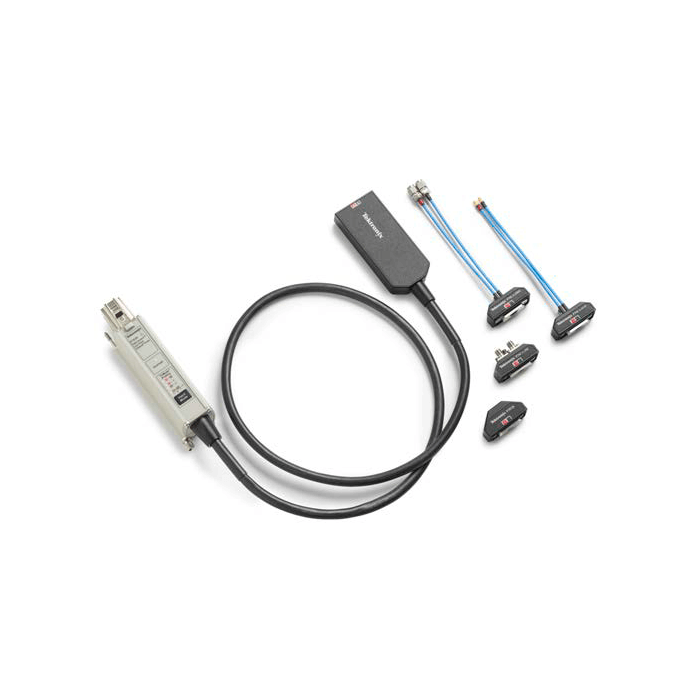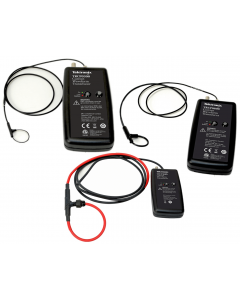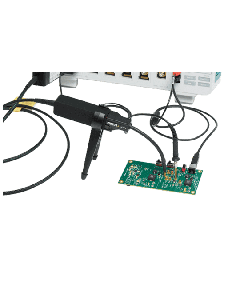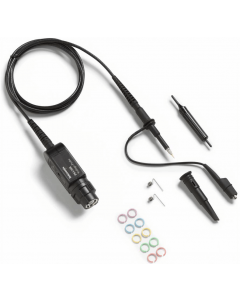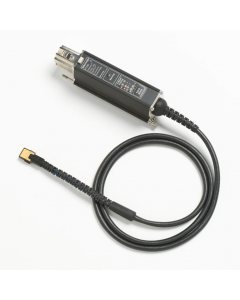
P7633
P7633
Tektronix
Low Noise TriMode™ Probe, 33 GHz, TekConnect Interface
Industry's lowest probe and oscilloscope system noise
The Tektronix P7633 TriMode probe and the MSO/DPO70000DX and DPO/DSA70000D Series Oscilloscopes are designed to deliver the industry's lowest system noise levels. This high sensitivity is critical for being able to make accurate measurements on low amplitude signals.
Combining TriMode probing with low-noise performance
TriMode probing enhances productivity by enabling differential, single-ended, and common mode measurements with a single probe setup. Connecting a probe to the device under test can be a time-consuming activity, especially if the probe has to be set up differently to make all the necessary measurements. TriMode probing improves productivity by reducing setup time because only one setup is needed to make the three different types of measurements. Switching between Differential Mode [A-B], Single-Ended Mode [A-Gnd, B-Gnd], and Common Mode [((A+B)/2)-Gnd] is as easy as a press of a button.
As high-speed serial data standards increase speed and signal swings shrink, probes with high bandwidth coupled with low noise and high sensitivity are increasingly important for accurate measurements.
The MSO/DPO70000DX and DPO70000SX Series oscilloscopes and the P7633 TriMode probe are designed to deliver the industry's lowest system noise levels. When used with P76CA-xxx Coaxial Adapters, the vertical setting on the oscilloscope can be set as low as 3.48 mV/div with a system noise <1.1 mVrms at 33 GHz bandwidth. This high sensitivity is critical for being able to make accurate measurements on low amplitude signals. The P7633 TriMode probe was designed to deliver superior sensitivity and allow the oscilloscope to directly measure small signals without using a zoom function. Using a zoom function to look at small signals does not change the intrinsic noise floor of the instrument which can make measurements on small signals problematic.
Connectivity
The Tektronix P7633 probe utilises an interchangeable active tip design built around a custom tip interface using high-frequency SMPM connectors. The P7633 features an Automatic Adapter ID function that recognises the attached adapter and automatically applies the correct DSP filters that eliminate imperfections in the frequency response all the way to the probe tip. This feature eliminates the risk of manually selecting the wrong tip type and is more efficient for the user.
Coaxial adapters
Coaxial adapters enable the probe to act like a differential input channel for the oscilloscope which effectively doubles the number of differential signals a single oscilloscope can measure simultaneously. 33 GHz Bandwidth Coaxial Adapter with 2.92 mm (Female) connectors. This adapter is calibrated at the input connectors and is ideal for use with off-the-shelf or custom cables. Low skew cable pairs should be used to preserve full bandwidth performance.
Unique probe filters
The Tektronix P7633 probe contains probe-specific S-parameter data. Attaching a P7633 probe to a MSO/DPO70000DX or DPO70000SX oscilloscope transfers this data to the instrument to create unique system DSP filters based on the specific S-parameter data of the oscilloscope and the probe. Creating unique filters based on the specific response of the system is critical as bandwidths increase. At bandwidths of 33 GHz, small variations in the signal path can lead to significant variation in frequency response. These variations are corrected using DSP filtering.
Click below to request a quote for this item. Or for product advice, stock and lead time enquiries call our team on 0330 313 3220.
| Attribute | Value |
|---|---|
| Product Segment | Low Voltage Differential Oscilloscope Probes |
| Product Family | Low Voltage Differential Oscilloscope Probes |
| Key Features |
|
| Bandwidth | 33 GHz |
| Applications |
|
| Probe Attenuation | 0.25/0.5/1/2/4 (coax) 1.25/2.5/5/10/20 (P76TA) |
| Input Impedance | 50 Ω / 225 Ω |
| Maximum Voltage | ±5 V (DC + pk AC) |
| Accessory Type | Low Voltage Differential Oscilloscope Probes |
| Attribute | Value |
|---|---|
| Data Sheet | Click here to view |

